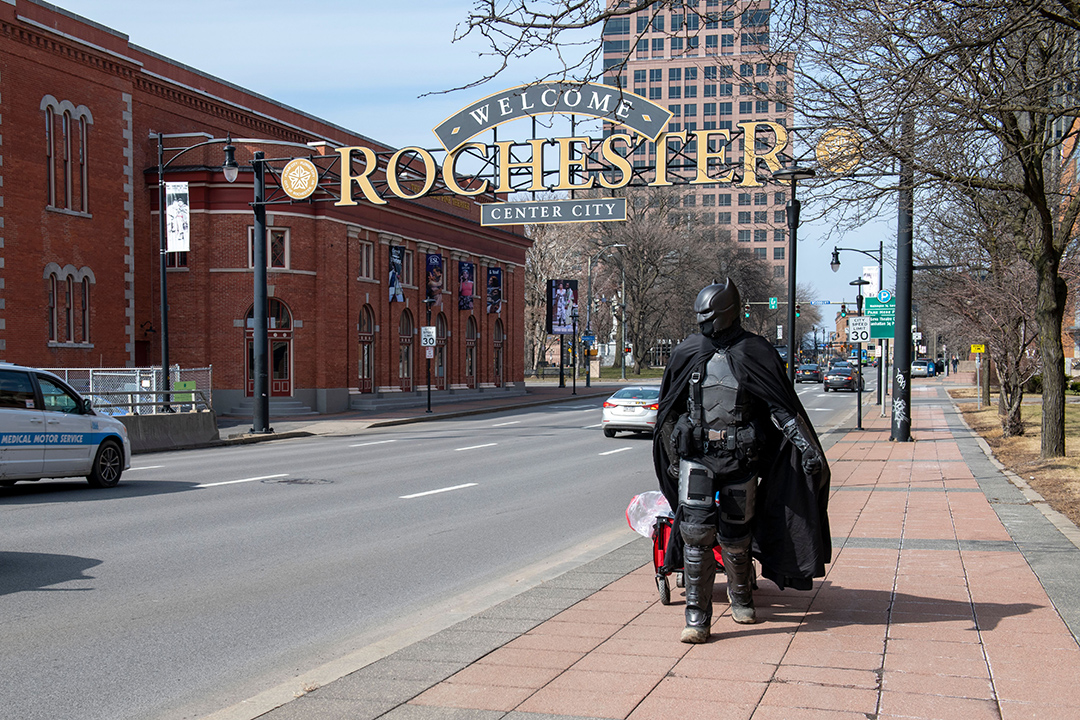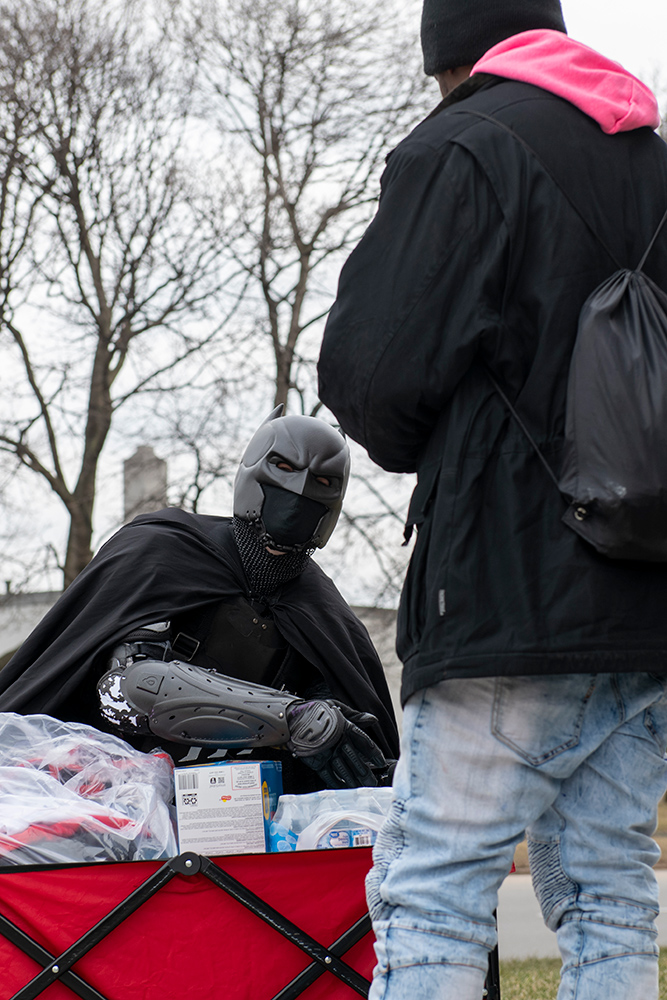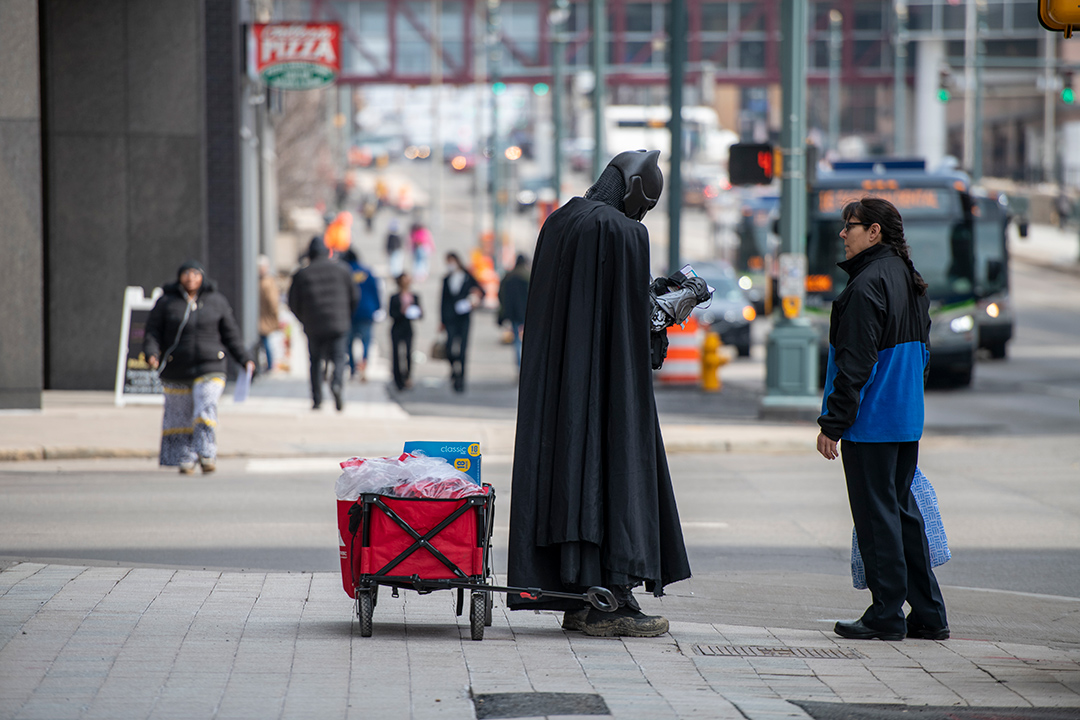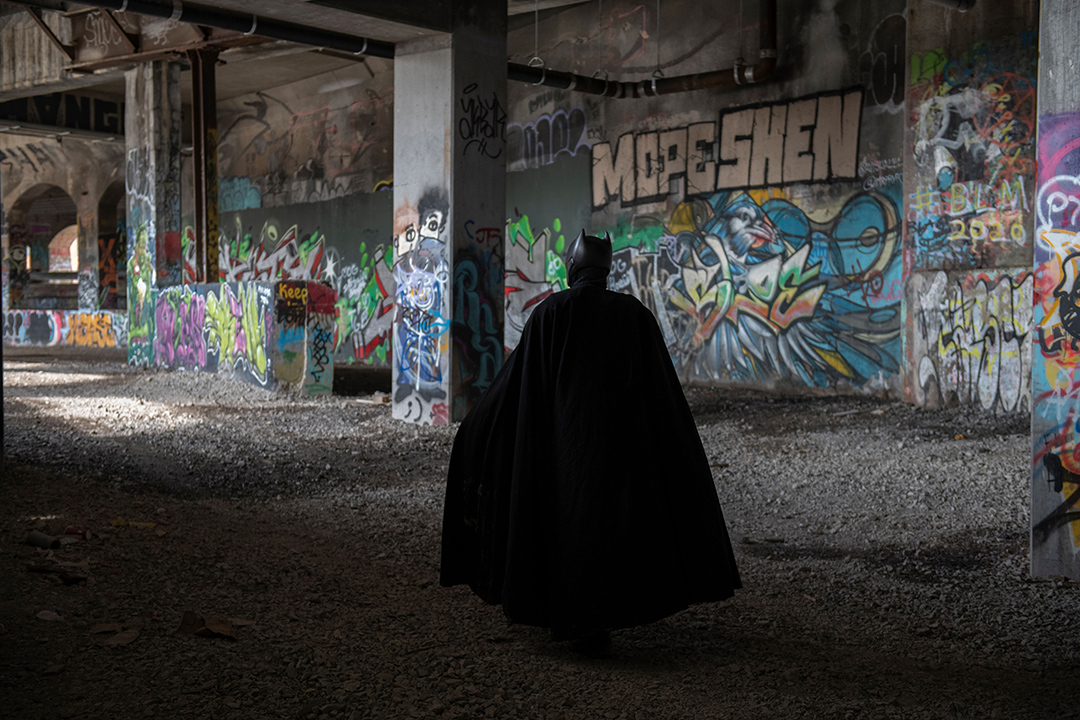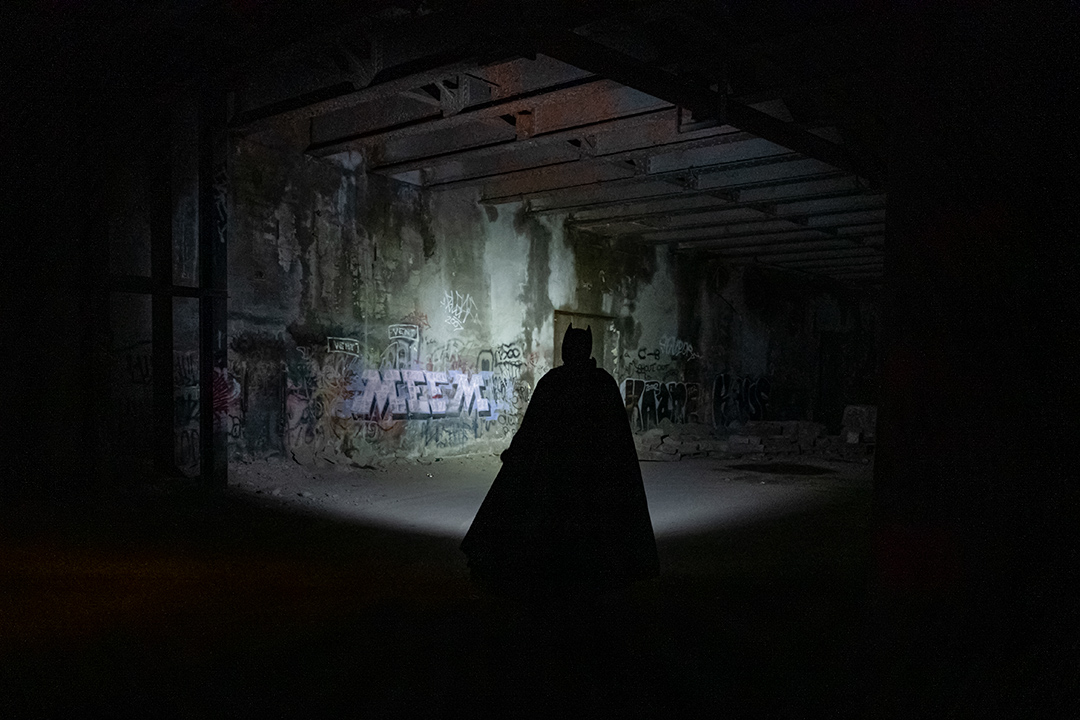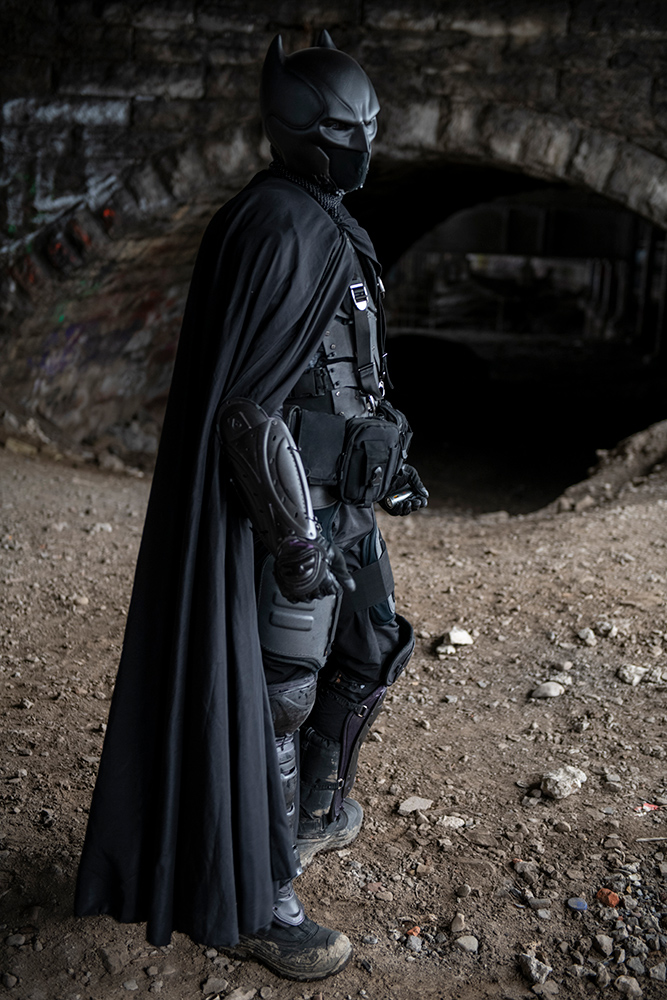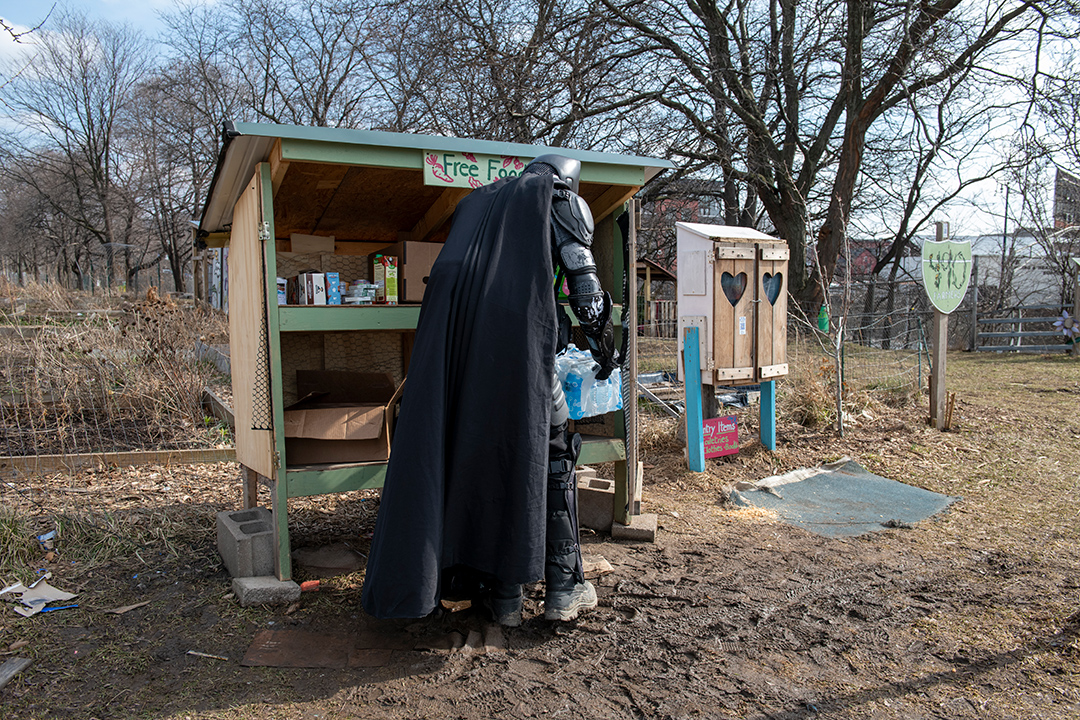RIT’s student Batman helps homeless on both coasts
Anonymous, heroic student dresses the part to raise awareness of housing and food insecurities
Elizabeth Lamark
An RIT industrial design student dresses as Batman as he walks the streets of Rochester, looking to help the homeless. Several thousands of dollars have been raised in four years to help pay for the supplies he gives away.
As many of his classmates spent spring break someplace warmer than Rochester, one Rochester Institute of Technology student stayed in town, donned a Batman costume, and provided food, water, and clothing to people in need.
Elizabeth Lamark
An RIT student dressed as Batman visits with a young man who had been holding a sign at a street corner asking for help. “I’m fine, now,” the man said, smiling, after receiving a bottle of water, some new socks and a package of corn chips.
This is what the student — who wants to remain anonymous to keep the focus on the issue of homelessness — prefers to do.
“I don’t want these people to be forgotten,” he said. “Every time we decide to look away or not think about it or not acknowledge that something is wrong, we’re actually allowing this to happen. All it takes is being kind and changing the narrative.”
It all started nearly four years ago, when he was a high school student in San Jose, Calif., and volunteered in a soup kitchen through his school. As soon as he got some cash from a part-time job, he bought some bottled water, a few cans of ravioli, socks, and underwear; divided them into three paper bags; and headed downtown.
He wore a Batman costume — a favorite character of his growing up — but was a bit fearful of approaching strangers, so he left two of the bags with people who were sleeping outdoors. The third, he gave to someone just a couple of years older than he was, who said he left his family because he wasn’t getting the psychological help he needed.
He decided to be more visible. “I felt I should have a presence downtown, so people know what’s going on, and I wanted people I distributed to to be familiar with me,” he said. “The more I spoke with people, the more I learned about people’s stories, the more my perception changed.”
Elizabeth Lamark
An RIT student dressed as Batman in downtown Rochester says walking is the best way to meet people and learn about the community. Here, he’s talking to a firefighter who gives him information about shelters.
He began buying more supplies and carried them in a suitcase until he realized a portable cart would best suit his needs and allow people to take what they needed.
Soon, he knew many of the names of the people he regularly encountered, and they certainly remembered him. Several news stories about the quiet hero resulted in more than 5,700 people following him on Instagram (@Batman_of_San_Jose) and many wanted to donate to help him buy supplies. Several thousand dollars have been donated, mostly in $5 and $10 increments.
For more
See Batman on RIT's TikTok channel.
Two years ago, Batman enrolled at RIT as an industrial design major. While at RIT, he even used a 3D printer to make his Batman mask, which is wrapped in thermoplastic. And while the homeless community is smaller in Rochester than in San Jose, there are people in need in every community, so he wasted no time and continued his outreach trips in downtown Rochester.
After shopping for items he’s going to give away, mixed with items donated by friends, such as hats, scarfs, and gloves, much of his time is spent looking for people to help. Strolling up and down sidewalks in the city, he gets plenty of people honking their horns as they drive by and many who get out of their cars to take a selfie with him.
Elizabeth Lamark
An RIT student dressed as Batman explores the abandoned subway bed in downtown Rochester as he looks to help the homeless
He obliges all requests and is quick to respond with a thumbs up and fist bumps.
During a visit to downtown Rochester last week, he soon saw a young man who had been holding a sign at an intersection asking for food.
Wearing his outfit, flowing cape and all, and pulling his supplies in a red cart with wobbly wheels behind him, Batman approached the man and asked how he was doing.
“I’m fine, now,” the young man said, smiling, after receiving a bottle of water, some new socks and a package of corn chips. “I’m going to go to the library today and get some things done. It’s going to be a productive day.”
Batman told the man to feel free to ask again if he saw him in the future and ever needed anything. Then he continued his trek looking for others to help under bridges, in alleys, parking garages, and parks.
Elizabeth Lamark
An RIT student dressed as Batman explores the abandoned subway bed in downtown Rochester as he looks to help the homeless. He goes as far inside as possible to make sure he’s not missing anyone.
A middle-aged man with a limp walked up and said hello, then returned a few minutes later. Batman asked if the man needed anything, and stood patiently as the man recited poetry he had written.
“Sometimes people just want to talk to someone who will listen,” Batman said. “It can just be saying ‘hi’ so they don’t just blend into the sidewalk, treating people like human beings so they don’t feel like they’re not worth it.”
Using crosswalks and waiting for lights to turn green at intersections, he pulled his cart behind him as his cape flapped in the wind, drawing more attention from passersby.
A busy location on this day was in front of the transit center on St. Paul Street.
Elizabeth Lamark
An RIT student dressed as Batman explores the abandoned subway bed in downtown Rochester as he looks to help the homeless. He goes as far inside as possible to make sure he’s not missing anyone.
“Hey, Batman!” someone shouted and soon, several people were surrounding him, taking what they needed. One man grabbed a package of underwear. An elderly man took bottles of water and some cans of soup and placed them in his shopping bags.
He knows Rochester’s dark, abandoned subway tunnels have been a haven for the homeless for many years, and after finding a way inside, uses his flashlight to light up the graffiti-covered walls to help him see. On his visit last week, he didn’t find anyone there – only evidence they had recently been living there.
Batman carries no money with him. He knows CPR, carries candy if he runs into someone in diabetic shock and even can administer Narcan if he encounters someone who has overdosed.
Back home in California, he’s had a knife drawn on him. He’s aware he could be vulnerable doing what he’s doing, but he says those he tries to help are more at risk.
He’s befriended many of the people he’s met on the street, and easily tears up when he talks about some of them, like a man named Tom who was released from a hospital with only the gown he was wearing because they needed his bed, even though he had medical insurance. He said Tom died the next day.
Elizabeth Lamark
An RIT student dressed as Batman deposits some food, water, and clothing at a makeshift community pantry called 490, right off the highway in downtown Rochester.
“I want people to realize the humanity of other people and treat them as human beings and not judge them on anything. Treat them as human beings first, foremost and always,” he said.
Each of his trips downtown last several hours and covers several miles. He’s emotionally and physically exhausted after each trip, and feels as though he could have done more.
“What I do is put a Band-Aid on a bullet wound,” he said. “What’s going to fix this problem is culture change and actual processes and programs that people can trust. That’s not just something some kid in a Halloween costume can change.”









